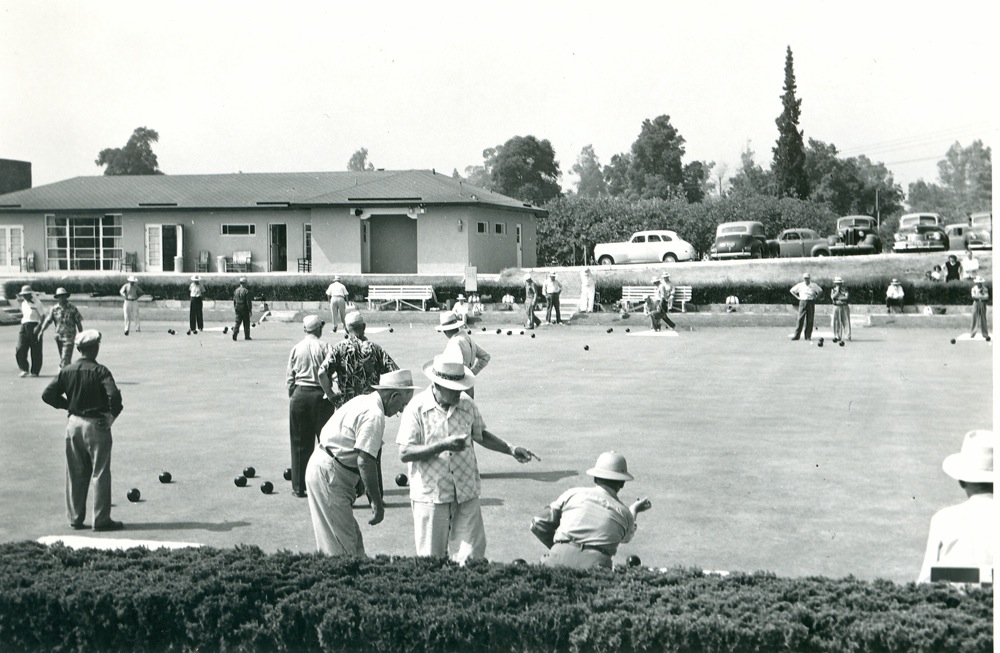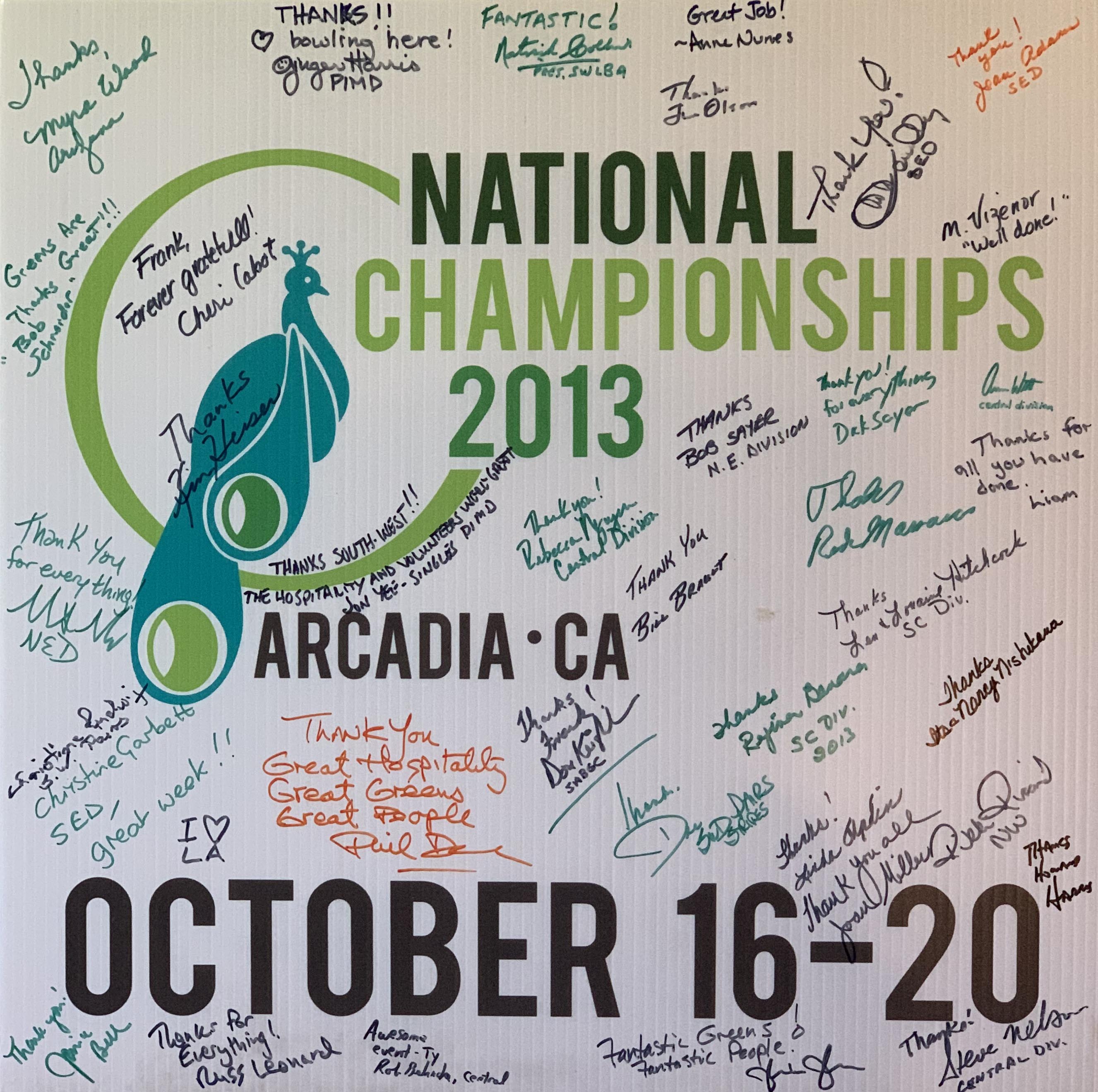Santa Anita Lawn Bowling Club

The Club's History
The land on which the Club's greens and clubhouse are located was once part of a 210-square-mile California Rancho, most of which was purchased in 1875 by Lucky Baldwin, who named it Rancho Santa Anita. Earlier, it had been part of a vast area of Southern California long populatd by the Tongva Indians, and part of the Spanish Mission San Gabriel. Over time, portions of Rancho Santa Anita were sold and eventually developed into the towns we know today as Arcadia, El Monte, Monrovia, and Sierra Madre, and parts of Pasadena and San Marino.
In 1918 Los Angeles County purchased 185 acres from Anita Baldwin for $92,000. Prior to the purchase, the land was part of Lucky Baldwin's original Santa Anita Racetrack. Then it was used for several years by the U.S. Army as a training camp.
In 1935, through an act of Congress, the War Department redeeded the 185 acres back to the county with the provision that it be used as a park and recreation center. The conversion of the site from an army camp into a recreational facility was a WPA project that employed 600 men and cost over $100,000. Ninety percent of the labor was done by hand, producing an 18-hole golf course, a swimming pool, a bath house, eight tennis courts, grandstands for the swimming pool and the tennis courts, a baseball stadium, a softball diamond, a children’s playground, and two lawn bowling greens. Can you imagine what the cost would be today?!
The Club is Formed
Bowling greens #1 and #2 were almost complete when a group of local men got together to form a lawn bowling club. They met in the Arcadia Chamber of Commerce rooms on June 17, 1937. There were 12 men at that initial meeting. At the next meeting, five days later on June 22, 1937, the twelve founding members were joined by an additional eight, and the organization officially became the Arcadia Bowling Green Club.
The ABGC was strictly a male organization, and only three of the organizers had any idea how to play the game. Jack Stanley, who moved to Arcadia from Oakland, California, where he was active in the club there, became the first president and agreed to teach the other members. He was joined by Ed Berry who also had some experience with the game.
The Early Years: 1937 - 1960
The club grew, and by the time the Pearl Harbor attack occurred in 1941 there were about 55 members. The war took a toll on the club's membership, which dropped to about 40. With the return of peace, membership quickly rebounded to about 75.
During the first ten years of the club’s existence it was without a clubhouse. Then in 1947, after years of lobbying, the club was able to persuade the county to appropriate $30,000 to build a clubhouse. The building was completed in 1948.
During this time, the club welcomed visiting groups of bowlers from Britain and Canada: a group of 30 British bowlers visited the club in 1947, and they were followed by a Canadian group in 1955, and by another British group in 1956.
The Ladies
In January 1949 several women formed their own club and began bowling. They associated themselves with the Southern California Women’s lawn bowling association and enjoyed bowling in tournaments throughout the state. The women's club was also active socially, holding parties and picnics to celebrate holidays.
By 1960, the membership of the women's club had dwindled to almost nothing. The men’s club decided to admit them, but only as Class B members, with no voting privileges. Class B memberships were eliminated in 1964 and the women became full members. The first women to join the club were Anna Bucher, Nellie Jerg, Susan Long, and Cathy Noren.
The Sixties, Seventies, and Beyond
The years 1962 and 1963 were good for the ABGC. Construction of a north wing room was completed and the club
was allowed to use it as a clubroom. At the same time, construction of Green #3 began.
And while all this construction was in progress, the club was visited by 31 men and 15 women from six
Australian lawn bowling clubs.
Up until about 1963 the ABGC was almost the only organization using the clubhouse.
Hardly a day went by that bowlers didn’t stay after their games to chat, eat lunch, and play bridge.
Once the new additions were completed more and more groups began to use the facility.
The County did not require any payment from the club for use of the greens, but the club nevertheless donated one half of all dues collected to the County. The County supervisors acknowledged the receipt of this money as a gift.
In 1966, the club decided to begin collecting fees specifically for the care of the greens.
The first fees were set at $18 per year.
Training classes were organized in the 1970s, which resulted in a rapidly increasing membership:
the membership tripled between 1971 and 1979.
In 1977 the club hosted the Women’s U.S. National Championships, and in 2013 hosted both the Women's and Men's National
Championships. Currently the club often hosts the Southwest Division Open.
The ABGC was one of the first lawn bowling clubs to stage charity events.
The first project, started by Joe Zook in 1965, was a Halloween party for children with learning disabilities,
Though it was a hit with everyone involved, it had to be discontinued in 1978 due to technical issues.
In recent years the club has held a City of Hope Triples Tournament to raise money for the City of Hope's
cancer research program. The City of Hope Tournament attracts lawn bowlers from across Southern California
As the club attracted new members from around the San Gabriel Valley it changed its name from
the Arcadia Bowling Green Club to the Santa Anita Bowling Green Club, and later to the Santa Anita
Lawn Bowling Club.
Over the years the partnership between the Santa Anita Lawn Bowling Club and the
Los Angeles County Department of Parks and Recreation has been a wonderful marriage.
The club has enjoyed tremendous support from the County, and in turn the club has provided valuable stewardship of the
greens at Arcadia Park and an important recreational activity for County residents, especially for its senior citizens.
Support from County Supervisors Michael Antonovich
and Kathryn Barger has been invaluable.
-- Distilled from documents written by Frank R. Jerome, Mike Eberle, and Gene Plunkett. 